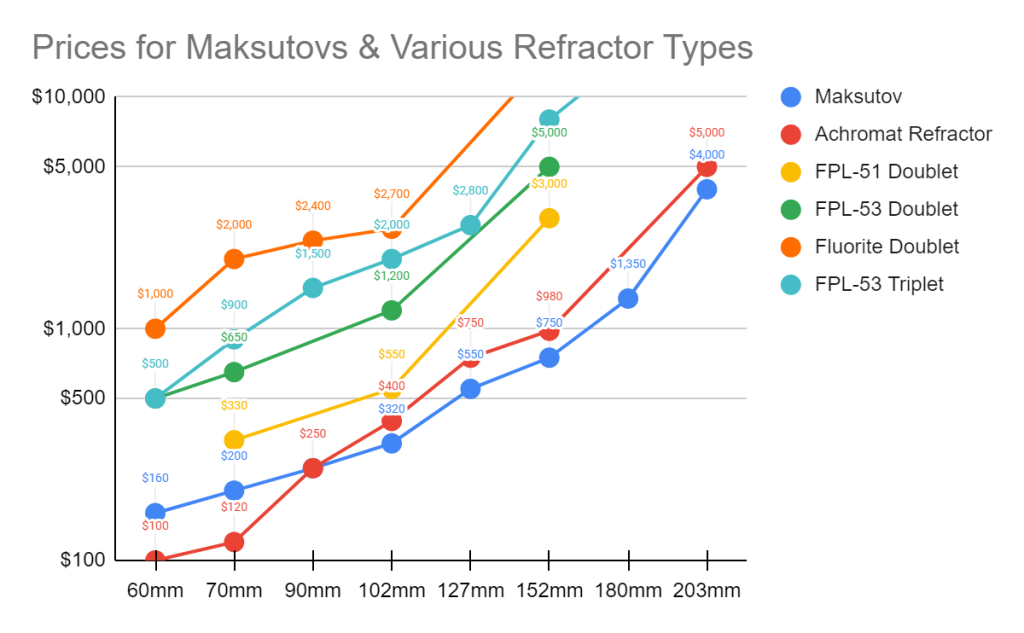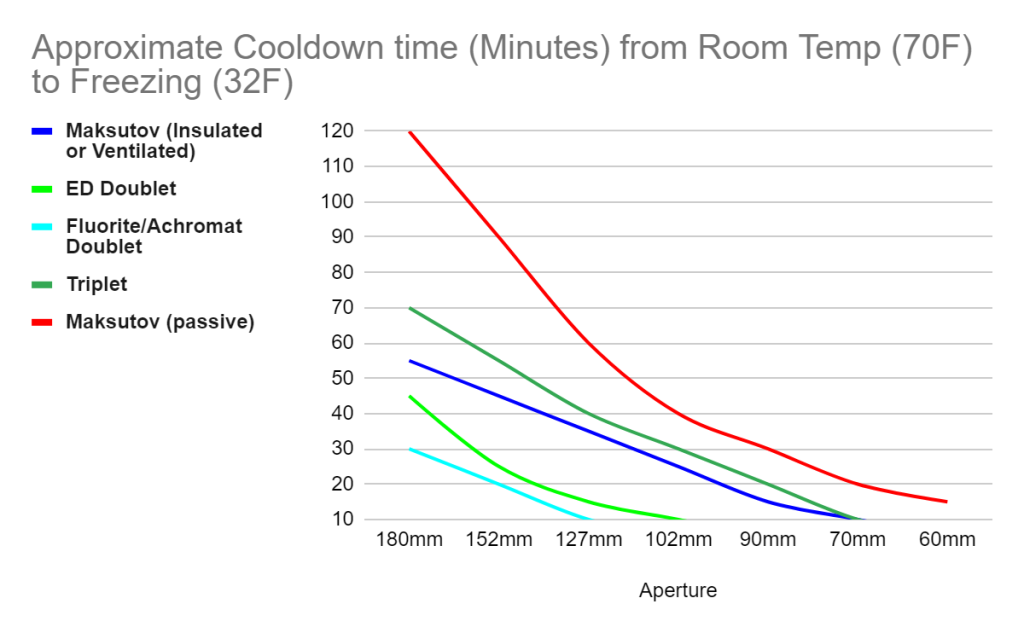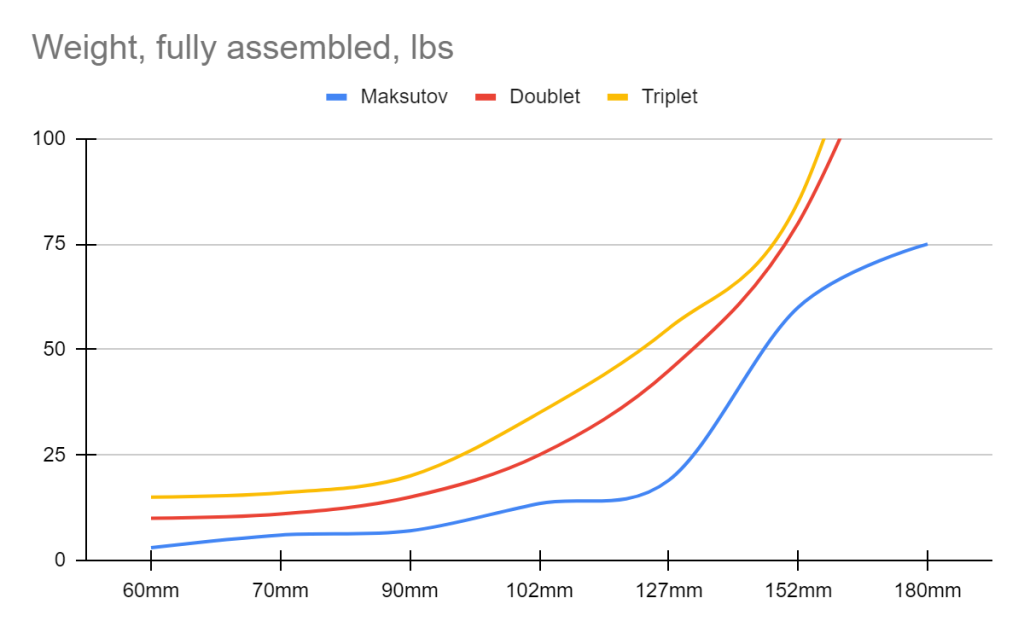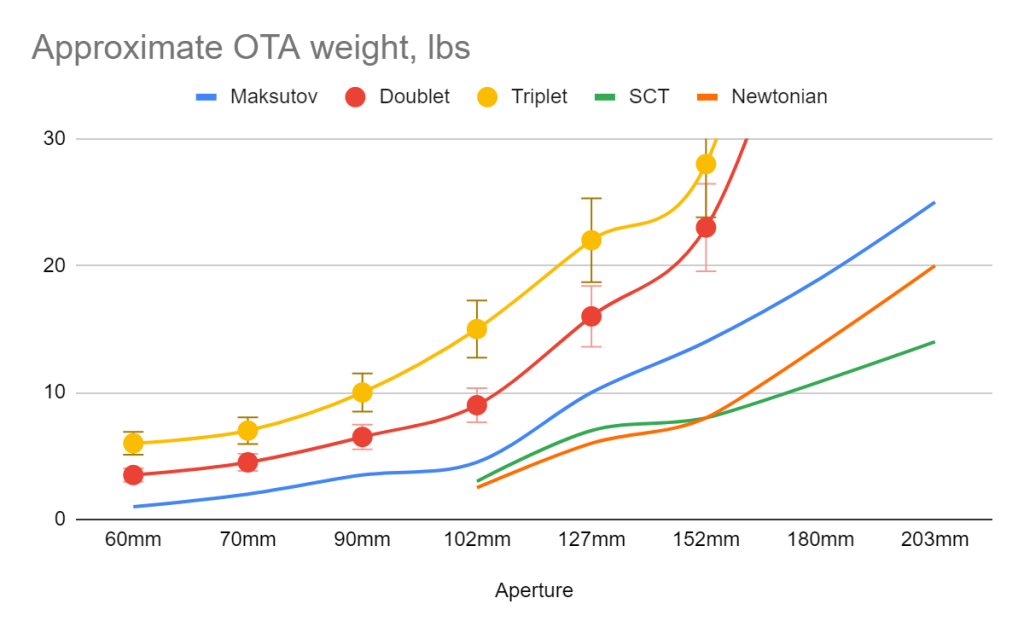High-performance refractor and Maksutov-Cassegrain telescopes both offer superb views of the Moon, planets, and double stars, with some of the best performance physically possible for a given aperture size. Both have advantages and disadvantages that can make them more or less suited for your purposes than the other.
In this article, we’ll be comparing achromat and apochromat refractors (which have their own differences and different properties) to Maksutov-Cassegrains for the purpose of visual observation. The choice of one over the other is not all that binary; their performance can be very good in either design and, more often than not, is such, but where exactly cost, aperture, convenience, and weight intersect is ultimately what will influence your decision.
Performance
Good refractors and Maksutov-Cassegrains are both reputed for high-resolution views with no diffraction spikes or fuzzy focus at high magnifications to worry about. This makes them ideal for viewing the Moon and planets, as well as splitting double stars. However, they are, of course, completely different in optical design and general usage.
Many refractors are optimized for wide-field viewing and deep-sky astrophotography, especially fast ED doublets. The best refractors for planetary and double star viewing tend to be slow f/ratio apochromats and achromats with optical configurations designed more for visual use than astrophotography. A fast achromat or imaging-oriented apochromat may have chromatic aberration at levels that make high-power viewing completely worthless and display poor resolution and clarity.
Maksutov-Cassegrains are almost always extremely slow in focal ratio, usually between f/12 and f/16. They are shorter than the most compact fast f/ratio apochromats but have no chromatic aberration due to their optical design. Unlike most other telescopes that use mirrors, Maksutov-Cassegrains hardly ever need collimation, and they are usually made to extremely high standards of quality. However, their long focal ratios and typically 1.25”-only eyepiece compatibility limit their field of view to the point that deep-sky viewing is not usually very good, with only small and bright targets being of much interest.
Both refractors and Maksutov-Cassegrains quickly become heavy, bulky, and unaffordable at apertures over about 7”. As such, these telescopes are rarely particularly powerful for deep-sky viewing, and you should instead consider a Schmidt-Cassegrain – or better yet, a Dobsonian – with an 8” or greater aperture if bold and bright views of nebulae, galaxies, and star clusters are important to you.
Cost

Refractors get expensive fast, especially if you want a good one. Achromats are somewhat comparable in price to a Maksutov-Cassegrain, but only the best achromats (which are often more expensive than the baselines on the price chart above) are true rivals to a good Maksutov-Cassegrain in performance. Maksutov-Cassegrains’ obstructed primary mirrors mean that they may end up delivering slightly inferior performance to a refractor of the same size, but it’s still usually cheaper to just buy a bigger Maksutov than a smaller refractor with similar performance. This gets especially true at larger apertures; a quality refractor over 4” (102mm) is often extremely expensive compared to a 6” (152mm) or 7” (180mm) Maksutov-Cassegrain.
The above chart is for optical tubes, but it gets even worse at larger apertures. Small refractors and Maksutov-Cassegrains can get away with lightweight equatorial and alt-azimuth mount designs that don’t cost very much. However, a 5” or 6” refractor requires a large, preferably driven equatorial mount. A 5” doublet works fine on a Celestron Advanced VX (a bit over $1,000 USD) or similar 30lb payload mount. A 5” triplet or 6” doublet, however, is just barely adequate on such a mount, and a 6” triplet will absolutely need an EQ6-class mount costing $2,000 USD or more. Meanwhile, a 5” or 6” Maksutov-Cassegrain still works on a fairly lightweight and affordable mount, while a 7-8” one just needs a medium-duty 20-30 lb payload capacity mount to be functional. For deep-sky imaging, of course, which only refractors are suited for, you can expect to double those weight capacity requirements, which further adds to the cost.
However, cost isn’t everything.
Convenience of Refractors vs. Maksutov-Cassegrains
Cooldown Time aka Thermals
One of the biggest factors when considering a telescope designed for high-resolution performance is cooldown time. You are probably aware that for good high-power performance, a large Newtonian reflector is prone to needing a decent amount of time for the primary mirror to acclimate to ambient temperature if taken from a warm indoor setting to a chilly field, but fans are easily installed, and when you factor in the time needed to collimate and/or assemble the telescope, the problem further diminishes. A small one in the 3-6” (70-152mm) aperture range often needs very little time to acclimate.
Small doublet refractors, likewise, can often acclimate to ambient temperature extremely quickly, depending on glass type – FPL51, fluorite, and achromat designs will cool down a little faster than an FPL-53 doublet on account of FPL-53’s greater expansion/contraction with temperature, though the time needed is still often negligible. However, larger refractors in the 5-6” range may take some time to cool down due to their thicker and heftier lenses, and triplets can be even worse in this regard. There is also pretty much no way to install fans on a refractor in a useful manner, and this would also be an easy way to cause dew or frost to form on the objective lens anyway. Cooldown time can also be affected by the star diagonal you use; removing it while you wait speeds up the process, and 2” diagonals hinder cooling more than 1.25” ones on account of their greater thermal mass.
Fortunately, most 6” and smaller doublets usually take no more than a half hour to acclimate from a typical indoor environment to freezing temperatures, and if you regularly observe on extremely cold nights, you could just put the telescope out before you go outside. Triplet apochromats may take longer to acclimate to the cold at larger apertures, but as with a big Dobsonian, the time you’ll often need to set a large/heavy scope up is probably going to negate that anyhow.
Maksutov-Cassegrains, however, are far more temperamental when it comes to their thermal properties. A Newtonian reflector has a big chunk of glass at the bottom of the tube, which is free to radiate heat up and away as well as off its back. A refractor just has a thick objective lens at the front. Schmidt-Cassegrains’ thin front correctors cool themselves rapidly but do trap the heat radiating from the primary in the tube; however, cooldown can still usually be fairly quick.
Maksutov-Cassegrains combine the worst of all three common telescope designs’ thermal properties. The thick Maksutov corrector itself needs to acclimate to ambient temperature, especially since it also usually constitutes the secondary mirror. The primary mirror of the Mak also has to cool, and it is pretty much blocked from radiating heat out the front by the thick front corrector. And, of course, light travels through the turbulent air in the tube three times, as opposed to twice for a reflector and once for a refractor.
In addition to the cost and focal length issues that come with a larger Maksutov, the primary reason you do not see these scopes at very large apertures has to do with thermals. The Stamford Observatory 22” Maksutov-Cassegrain, which the author is familiar with, is one of the largest Maksutov-Cassegrains ever built. It uses a corrector several inches thick, which in the original telescope was not helped by the equally thick (and unnecessarily so) primary mirror and steel cell behind it. Without any real ventilation, the only time the telescope’s otherwise-exceptional optics could perform as promised was when the telescope and outside air were near equal in temperature and the turbulent New England skies also remained steady – something that might only occur once every year or so. Modifications to help the scope cool down will be made at its new location, but it’s still a nightmare.
Small Maksutov-Cassegrains in the 90-127mm range are, in most climates, able to cool down to ambient temperatures within no more than 20-30 minutes from room temperature to near-freezing without any additional aid. This is not the near-instant cooldown you would get with a refractor of this size, but it is still fairly quick. However, larger ones, such as the common 6” and 7” units made by a variety of manufacturers, need some help. Most do not have vents at all, except for the old Meade 7” Maksutov, which is notorious for having a cast-iron counterweight in the back that blocks the fans from actually doing their job unless it is removed.
Wrapping reflective insulation around the tube can help the inside from getting too warm in the first place as well as prevent rapid air currents from forming when the telescope is suddenly exposed to a cooler environment, and you can buy or make a nozzle cooling system (essentially a fan with a pipe and an air filter on it) to stick inside the scope before inserting a diagonal, which can shorten cooldown time to something more reasonable. The thick corrector of Maksutov-Cassegrains is not very prone to dew, but you should still be especially sure to use a dew shield if you actively cool the scope with fans.
You can see the massive contrast in cooldown times that a Maksutov has compared to most refractors as well as the difference thermal management makes in the chart below.

Weight
Doublet refractors and Maksutov-Cassegrains are roughly on par in weight at typical sizes. However, refractors quickly gain mass at larger apertures, especially if they are triplets.

The above chart shows the approximate weights of various telescope types as an optical tube only. However, since a heavier tube needs a heavier mount and a Maksutov-Cassegrain’s stubby tube typically won’t need tripod legs to be extended when aimed high in the sky or induce as much torque, weight with a mount gets a little more lopsided.

The weight of a triplet is of course inherently higher than a doublet, but past a certain point the difference becomes negligible as both require monster mounts to support them. Maksutov-Cassegrains not only start out lighter than refractors to begin with, but as mentioned above in the “Cost” section, around 5” / 120-127mm aperture refractors hit a cliff requiring increasingly substantial mounts to adequately support them, whereas Maksutov-Cassegrains and their Schmidt-Cassegrain cousins only jump to requiring a big mount around the 7” mark and do not really need a titanic level of support even at the limits of their available aperture ranges.
